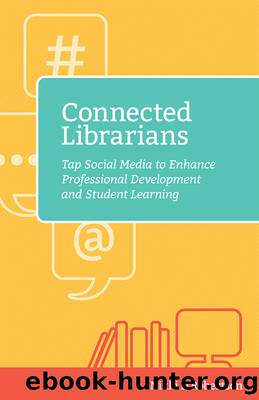Connected Librarians by Robertson Nikki D.;

Author:Robertson, Nikki D.; [Robertson, Nikki D]
Language: eng
Format: epub
Publisher: International Society for Technology in Education
Published: 2017-08-15T00:00:00+00:00
Hashtags are the key to unlocking the magic of Twitter. I once attended a school library conference and sat in on a session about using Twitter to connect and learn. I excitedly created a Twitter account and then, after letting it sit idle for some time, wondered why nothing was happening. I stumbled upon Shelly Terrellâs 30 Goals Challenge and through participating in the challenge was introduced to the #EdChat hashtag. After several #EdChat Twitter chat sessions, the lights turned on for me as I realized hashtags helped to make sense of the ânoiseâ on Twitter. What I refer to as the ânoiseâ is found on the home stream in Twitter. The home stream shows you what every single person you are following is tweeting. If you are following 500 people on Twitter, your home stream will reflect tweets from 500 different people about 500 different topics. Imagine you were in a room with all these people, and they were all talking to you at the same time. Crazy, right? Hashtags quiet that noise into one focused stream of common thought. For example, the #EdChat hashtag narrows the conversation to education-related topics. During the #EdChat Twitter chat sessions, the conversation is further narrowed to one specific educational topic. Twitter is my all-time, number one, favorite social media tool I use when I really want to connect with other educators around the globe. Specifically, Twitter chats leave me renewed and energized, filled with great ideas to take back to my school and valuable connections with other educators.
I like to assist my teachers in finding hashtags suited to their professional interests. Often, I will tweet about a really impressive lesson and include the teacherâs Twitter handle and a hashtag specific to their professional teaching field. For instance, Ms. Walker, a third-grade teacher, started using Google Classroom with her students. She focused on using the toolâs ability to provide formative assessment throughout the writing process with her students. I watched as, week after week, she led her students to more writing challenges and witnessed their writing bloom with her guidance and use of Google tools. I took the student workâdescriptive paragraphs about their favorite Thanksgiving dessertsâand made a student blog post out of it. I shared the blog post using several different hashtags to reach several different educational communities. Providing a real-world platform is an excellent way to celebrate studentsâ hard work and elevates their efforts beyond a simple grade.
I use the #Comments4Kids hashtag when I want to get feedback from other teachers and students about student work. I also make sure to return the favor by providing feedback as well for other educators tweeting with the #Comments4Kids hashtag.
I used the #3rdChat hashtag to increase readership of the studentsâ discriptive paragraphs, but I was also modeling hashtag use and building a PLN for Ms. Walker. The hashtag #3rdChat is where third-grade teachers across the country connect to share lessons, celebrate their students, ask for ideas to spice up outdated lessons, and more.
I also
Download
This site does not store any files on its server. We only index and link to content provided by other sites. Please contact the content providers to delete copyright contents if any and email us, we'll remove relevant links or contents immediately.
| Arts & Humanities | Health |
| Language Arts | Library Skills |
| Mathematics | Reading & Phonics |
| Science & Technology | Social Studies |
The Art of Coaching Workbook by Elena Aguilar(48364)
Trainspotting by Irvine Welsh(20095)
Twilight of the Idols With the Antichrist and Ecce Homo by Friedrich Nietzsche(17724)
Fangirl by Rainbow Rowell(7852)
Periodization Training for Sports by Tudor Bompa(7346)
Change Your Questions, Change Your Life by Marilee Adams(6668)
This Is How You Lose Her by Junot Diaz(5805)
Grit by Angela Duckworth(4751)
Red Sparrow by Jason Matthews(4693)
Asking the Right Questions: A Guide to Critical Thinking by M. Neil Browne & Stuart M. Keeley(4608)
Paper Towns by Green John(4179)
Room 212 by Kate Stewart(4121)
Ken Follett - World without end by Ken Follett(3984)
The Sports Rules Book by Human Kinetics(3602)
Housekeeping by Marilynne Robinson(3427)
The Motorcycle Diaries by Ernesto Che Guevara(3348)
Introduction to Kinesiology by Shirl J. Hoffman(3308)
Exercise Technique Manual for Resistance Training by National Strength & Conditioning Association(3307)
Double Down (Diary of a Wimpy Kid Book 11) by Jeff Kinney(3289)
